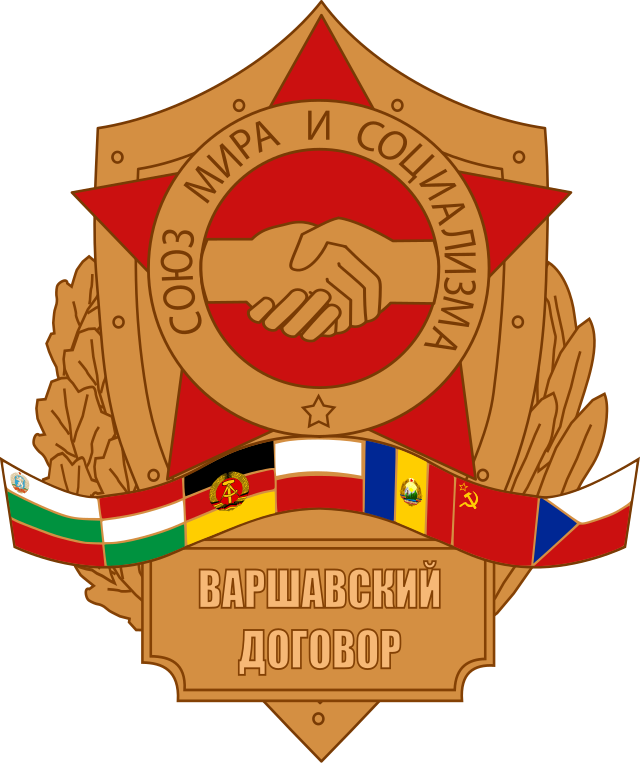Warsaw Pact: Difference between revisions - Wikipedia
 Article Images
Article Images
Line 32:
{{Eastern Bloc sidebar}}
[[File:Logo The Warsaw Pact.jpg|thumb|200px|Logo Military unit Organization The Warsaw Pact. ''Union of peace and socialism'']]
The '''Warsaw Pact''' (formally, the '''Treaty of Friendship, Co-operation, and Mutual Assistance''', sometimes, informally '''WarPac''', akin in format to [[NATO]])<ref name="Text of Warsaw Pact">{{cite web|url=http://treaties.un.org/doc/Publication/UNTS/Volume%20219/volume-219-I-2962-Other.pdf|title=Text of Warsaw Pact|publisher=United Nations Treaty Collection|accessdate=22 August 2013}}</ref> was a [[collective defense]] treaty among eight [[communist state]]s of [[Central and Eastern Europe]] in existence during the [[Cold War]], led by the [[USSR]]. The Warsaw Pact was the military complement to the [[Council for Mutual Economic Assistance]] (CoMEcon), the regional economic organization for the communist states of Central and Eastern Europe. The Warsaw Pact was acreated Soviet militaryin reaction to the integration of [[West Germany]] into [[NATO]]<ref name="NATO Transformed: The Alliance's New Roles in International Security"/><ref name="History Channel 1"/><ref name="History Channel 2"/><ref intoname="NATO short history">"In reaction to West Germany’s [[NATO]] accession, the Soviet Union and its Eastern European client states formed the Warsaw Pact in 1955." Citation from: {{cite web|text= |last1=NATO website|title=A short history of NATO|url=http://www.nato.int/history/nato-history.html|website=nato.int|accessdate=24 December 2015}}</ref> in 1955 per the [[Paris Pacts]] of 1954,<ref name="The Future of European Alliance Systems"/><ref name="christopher"/><ref name="enclopedia"/><ref>The Warsaw Pact Reconsidered: International Relations in Eastern Europe, 1955-1969
Laurien Crump Routledge,page 21-22, 11.02.2015 </ref><ref>The Oder-Neisse Line: The United States, Poland, and Germany in the Cold War
Debra J. Allen page 158 "Treaties approving Bonn's participation in NATO were ratified in May 1955...shortly thereafter Soviet Union...created the Warsaw Pact to counter the perceived threat of NATO"</ref> but it is also considered to have been primarily motivated by Soviet desires to maintain control over military forces in Central and Eastern Europe;<ref name="Warsaw Pact: Wartime Status-Instruments of Soviet Control"/> Its creation was especially supported by Eastern Germany, Poland and Czechoslovakia, who sought security of their unrecognized borders with Germany<ref>The Warsaw Pact Reconsidered: International Relations in Eastern Europe, 1955-1969
Line 69:
[[File:Military power of NATO and the Warsaw Pact states in 1973.svg|thumb|'''The Cold War (1945–90):''' NATO vs. the Warsaw Pact, the status of forces in 1973]]
Before creation of Warsaw Pact, fearing Germany rearmed, Czechoslovak leadership sought to create security pact with East Germany and Poland.<ref>The Warsaw Pact Reconsidered: International Relations in Eastern Europe, 1955-1969
Laurien Crump Routledge,page 21-22, 11.02.2015 </ref> These state protested strongly against re-militarization of West Germany.<ref>Europa Antoni Czubiński Wydawn. Poznańskie, 1998, page 298</ref> The Warsaw Pact was primarly initiatedput byin place as a consequence of the rearming of West Germany inside NATO. Soviet leaders, as many European countries in both western and eastern side, feared Germany being once again a military power as a direct threat. <ref name="History Channel 1"/><ref name="History Channel 2"/><ref name="US Dept State Historian">"When the Federal Republic of Germany entered NATO in early May 1955, the Soviets feared the consequences of a strengthened NATO and a rearmed West Germany". Citation from:{{cite web|last1=[[United States Department of State]]|first1=Office of the Historian|title=The Warsaw Treaty Organization, 1955|url=https://history.state.gov/milestones/1953-1960/warsaw-treaty|website=Office of the Historian|publisher=history.state.gov|accessdate=24 December 2015}}</ref> As Soviet Union had already bilateral treaties with all of its eastern satellites, the Pact has been long considered 'superfluos',<ref>The Warsaw Pact Reconsidered: International Relations in Eastern Europe, 1955-1969▼
Laurien Crump Routledge,page 21-22, 11.02.2015 </ref> These state protested strongly against re-militarization of West Germany<ref>Europa
▲Antoni Czubiński Wydawn. Poznańskie, 1998, page 298</ref> The Warsaw Pact was primarly initiated by the rearming of West Germany inside NATO. Soviet leaders, as many European countries in both western and eastern side, feared Germany being once again a military power as a direct threat. <ref name="History Channel 1"/><ref name="History Channel 2"/> As Soviet Union had already bilateral treaties with all of its eastern satellites, the Pact has been long considered 'superfluos',<ref>The Warsaw Pact Reconsidered: International Relations in Eastern Europe, 1955-1969
Laurien Crump Routledge,pag. 17, 11.02.2015 </ref> and because of the rushed way in which it was conceived, NATO officials labeled it as a 'cardboard castle'.<ref>The Warsaw Pact Reconsidered: International Relations in Eastern Europe, 1955-1969
Laurien Crump Routledge, pag. 1, 11.02.2015 </ref>